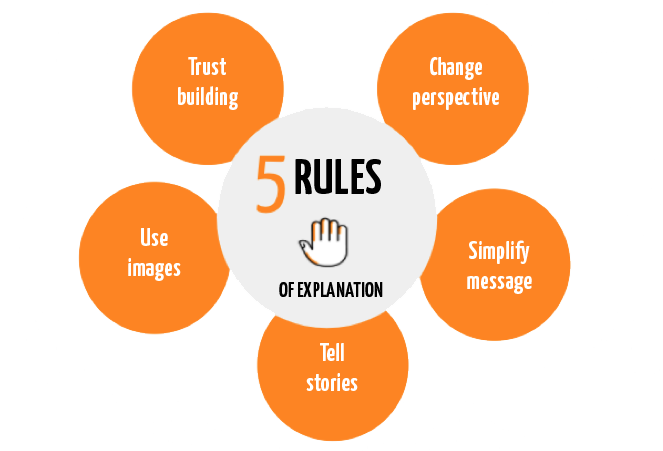
Our expert tips for a good script – Part 1

The five rules of explaining made easy
Are you familiar with the five rules of explaining made easy? They help us create effective explainer video scripts. Below, you’ll find a brief description of each of the five points—we’ll deal with these in greater depth later on.

Change perspective

Before getting to work on your content, ask yourself who this explainer video is actually for. Who is your target group? What does your target group know? What are their needs, fears and concerns?
Put yourself in your audience’s shoes and try and see your topic through their eyes. This will help ensure that your explainer video hits the right note for your target group, allowing you to discover what’s really important to its members and which content you can discard in the next step.
|
Tim |
Try and put yourself in the position of your target group! Ask yourself a couple of questions as you do so: Who’s your audience? How old are they? What function do they have, and what do they already know about this topic? Think about how you can best reach them. This will ensure your target group receives precisely the information it requires, and your simpleshow will be a complete success! |
Simplify your message – the essentials

To successfully simplify your content, you should reduce it to the absolutely essential information. That’s not always easy. We usually tend to find almost everything important—after all, the content we intend to communicate has been chosen deliberately. Clear objectives can help here.
Initially, it’s important to work out what the precise goal of this particular explainer video you’re creating is. In the process, try to think as specifically and concretely as possible, and call yourself to account when you’re tempted to include content that is only generally relevant. Be honest, and check whether this content actually benefits your simpleshow or would be better off being used in another simpleshow or another form of communication.
When you’ve figured out exactly what the aim and target group of your explainer video are, eliminate all content which isn’t essential to these.
|
Steffi |
As a concept writer, I like to take a structured approach. It helps to draft a rough overview before I start writing a script. Initially, I note down the relevant content as bullet points, or arguments, and rank them in order of importance. Afterwards, I allocate each argument a single scene in the simpleshow, thus creating my structure. This can take the following form, for example: Lead-in, introduction of character, argument 1, advantages, drawbacks, argument 2, benefit for the character, conclusion. I subsequently develop a story that fits the topic and adapt this to the structure of my bullet points. This makes it easier for me to create a fitting storyline without omitting or repeating key points. |

Simplify your message – simple language
Clear, simple language helps you to simplify your message. Most people are used to writing long sentences, frequently using the passive voice and peppering their paragraphs with countless nouns.
Use these rules to check your content and your finished script, and simplify your language quickly and easily!
|
Oliver |
When I write, I avoid long sentences and fillers, as complex subordinate clauses are hard to understand. Many adverbs (“extremely”, “very”, “incredibly” …) are often redundant as well. When I’m done with my script, I read my text out loud several times and ensure that the language flows well. If I’ve got it right, it should sound really fluent and perfectly suited to a simpleshow. |
It’s not easy to write a good explanatory video script. In addition to simplifying the message and language, the use of images and the right application of structure and storytelling also play a crucial role. More on this tomorrow – in the second part of our expert tips.


